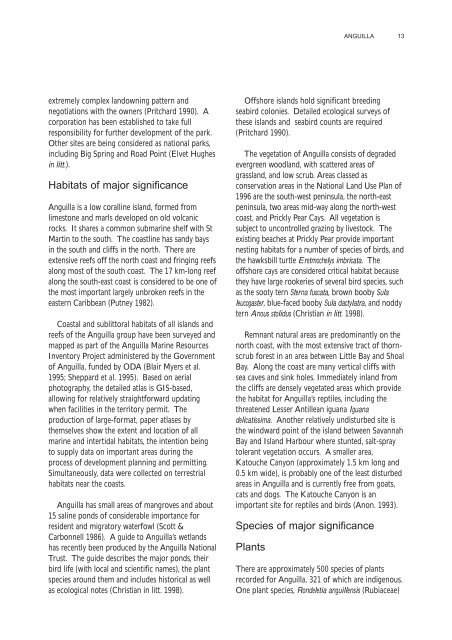Biodiversity: the UK Overseas Territories - WIDECAST
Biodiversity: the UK Overseas Territories - WIDECAST
Biodiversity: the UK Overseas Territories - WIDECAST
Create successful ePaper yourself
Turn your PDF publications into a flip-book with our unique Google optimized e-Paper software.
ANGUILLA<br />
13<br />
extremely complex landowning pattern and<br />
negotiations with <strong>the</strong> owners (Pritchard 1990). A<br />
corporation has been established to take full<br />
responsibility for fur<strong>the</strong>r development of <strong>the</strong> park.<br />
O<strong>the</strong>r sites are being considered as national parks,<br />
including Big Spring and Road Point (Elvet Hughes<br />
in litt.).<br />
Habitats of major significance<br />
Anguilla is a low coralline island, formed from<br />
limestone and marls developed on old volcanic<br />
rocks. It shares a common submarine shelf with St<br />
Martin to <strong>the</strong> south. The coastline has sandy bays<br />
in <strong>the</strong> south and cliffs in <strong>the</strong> north. There are<br />
extensive reefs off <strong>the</strong> north coast and fringing reefs<br />
along most of <strong>the</strong> south coast. The 17 km-long reef<br />
along <strong>the</strong> south-east coast is considered to be one of<br />
<strong>the</strong> most important largely unbroken reefs in <strong>the</strong><br />
eastern Caribbean (Putney 1982).<br />
Coastal and sublittoral habitats of all islands and<br />
reefs of <strong>the</strong> Anguilla group have been surveyed and<br />
mapped as part of <strong>the</strong> Anguilla Marine Resources<br />
Inventory Project administered by <strong>the</strong> Government<br />
of Anguilla, funded by ODA (Blair Myers et al.<br />
1995; Sheppard et al. 1995). Based on aerial<br />
photography, <strong>the</strong> detailed atlas is GIS-based,<br />
allowing for relatively straightforward updating<br />
when facilities in <strong>the</strong> territory permit. The<br />
production of large-format, paper atlases by<br />
<strong>the</strong>mselves show <strong>the</strong> extent and location of all<br />
marine and intertidal habitats, <strong>the</strong> intention being<br />
to supply data on important areas during <strong>the</strong><br />
process of development planning and permitting.<br />
Simultaneously, data were collected on terrestrial<br />
habitats near <strong>the</strong> coasts.<br />
Anguilla has small areas of mangroves and about<br />
15 saline ponds of considerable importance for<br />
resident and migratory waterfowl (Scott &<br />
Carbonnell 1986). A guide to Anguilla’s wetlands<br />
has recently been produced by <strong>the</strong> Anguilla National<br />
Trust. The guide describes <strong>the</strong> major ponds, <strong>the</strong>ir<br />
bird life (with local and scientific names), <strong>the</strong> plant<br />
species around <strong>the</strong>m and includes historical as well<br />
as ecological notes (Christian in litt. 1998).<br />
Offshore islands hold significant breeding<br />
seabird colonies. Detailed ecological surveys of<br />
<strong>the</strong>se islands and seabird counts are required<br />
(Pritchard 1990).<br />
The vegetation of Anguilla consists of degraded<br />
evergreen woodland, with scattered areas of<br />
grassland, and low scrub. Areas classed as<br />
conservation areas in <strong>the</strong> National Land Use Plan of<br />
1996 are <strong>the</strong> south-west peninsula, <strong>the</strong> north-east<br />
peninsula, two areas mid-way along <strong>the</strong> north-west<br />
coast, and Prickly Pear Cays. All vegetation is<br />
subject to uncontrolled grazing by livestock. The<br />
existing beaches at Prickly Pear provide important<br />
nesting habitats for a number of species of birds, and<br />
<strong>the</strong> hawksbill turtle Eretmochelys imbricata. The<br />
offshore cays are considered critical habitat because<br />
<strong>the</strong>y have large rookeries of several bird species, such<br />
as <strong>the</strong> sooty tern Sterna fuscata, brown booby Sula<br />
leucogaster, blue-faced booby Sula dactylatra, and noddy<br />
tern Anous stolidus (Christian in litt. 1998).<br />
Remnant natural areas are predominantly on <strong>the</strong><br />
north coast, with <strong>the</strong> most extensive tract of thornscrub<br />
forest in an area between Little Bay and Shoal<br />
Bay. Along <strong>the</strong> coast are many vertical cliffs with<br />
sea caves and sink holes. Immediately inland from<br />
<strong>the</strong> cliffs are densely vegetated areas which provide<br />
<strong>the</strong> habitat for Anguilla’s reptiles, including <strong>the</strong><br />
threatened Lesser Antillean iguana Iguana<br />
delicatissima. Ano<strong>the</strong>r relatively undisturbed site is<br />
<strong>the</strong> windward point of <strong>the</strong> island between Savannah<br />
Bay and Island Harbour where stunted, salt-spray<br />
tolerant vegetation occurs. A smaller area,<br />
Katouche Canyon (approximately 1.5 km long and<br />
0.5 km wide), is probably one of <strong>the</strong> least disturbed<br />
areas in Anguilla and is currently free from goats,<br />
cats and dogs. The Katouche Canyon is an<br />
important site for reptiles and birds (Anon. 1993).<br />
Species of major significance<br />
Plants<br />
There are approximately 500 species of plants<br />
recorded for Anguilla, 321 of which are indigenous.<br />
One plant species, Rondeletia anguillensis (Rubiaceae)
















